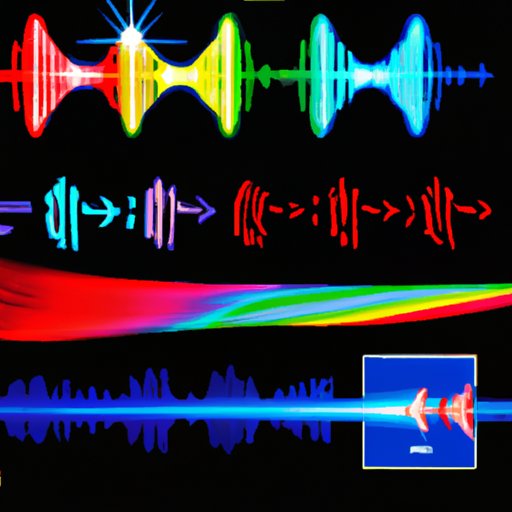
Introduction
Have you ever been asked to calculate the frequency of a wave given its wavelength? Calculating frequency from wavelength is an essential skill that is required in various fields, from telecommunications to spectroscopy and astronomy. Understanding this relationship helps us comprehend the nature of waves and their behavior, making it a crucial aspect of problem-solving and innovation in different industries. In this article, we will provide a step-by-step guide and formulaic approach to calculate frequency from wavelength. We will also explore real-world applications, an interactive guide, infographics, and a Q&A section.
Step-by-Step Guide
To calculate the frequency of a wave (f) given its wavelength (λ), we use the formula: f = c/λ, where c is the speed of light.
We break down the formula into simple, easy-to-understand steps:
1. Identify the speed of light: The speed of light is a constant that is approximately 299,792,458 meters per second (m/s).
2. Determine the wavelength: The wavelength is the distance between two corresponding points on a wave. It can be measured in meters (m).
3. Plug in the values: Simply divide the speed of light by the wavelength to get the frequency of the wave.
For example, if the wavelength of a wave is 2 meters, the frequency would be:
f = c/λ
f = 299,792,458 / 2
f = 149,896,229 Hz
It’s important to watch out for common mistakes, such as using the wrong units or not considering the decimal places. Always double-check your calculations before submitting the answer.
Formulaic Approach
The f = c/λ formula is versatile and can be manipulated to solve for different variables. For instance, we can solve for the wavelength using the frequency and the speed of light:
λ = c / f
Additionally, the speed of light in a given medium can affect the frequency of a wave. For example, in water, the speed of light is about 25% slower than in a vacuum, so the frequency of a wave changes accordingly. Therefore, it’s essential to know the speed of light in the medium where the wave is traveling.
By learning how to manipulate the f = c/λ formula and knowing the speed of light in different media, we can use this relationship to solve problems in a variety of scenarios.
Real-World Applications
The ability to calculate frequency from wavelength is incredibly useful in various fields. In telecommunications, for example, it helps engineers determine the signal frequency for radio and television broadcasting. In astronomy, it helps scientists measure the distance between galaxies. In spectroscopy, it helps identify unknown substances by analyzing the light they emit or absorb.
One practical application is in medical imaging technology, such as MRI. In MRI, frequency and wavelength are used to generate high-resolution images of the human body. By sending pulses of radio waves into the body at specific frequencies, a computer can use the data to construct an image of the body’s internal structure.
Interactive Guide
An interactive guide is an excellent way to engage readers in learning how to calculate frequency from wavelength. Interactive quizzes and challenges can test readers’ abilities and reinforce their understanding of the concepts.
One such quiz might ask readers to calculate the frequency of a wave given its wavelength and the speed of light. The quiz could provide feedback and explanations for each question, ensuring readers understand where they went wrong and how to correct their mistakes.
Infographics
Using infographics can help readers visualize the concepts of frequency and wavelength and how they relate. Infographics can break down the f = c/λ formula and provide clear explanations of each variable.
Infographics are particularly useful for conveying complex concepts in a simplified and illustrative manner. By using diagrams, color-coding, and other visual cues, infographics can help readers understand the relationships between different variables and appreciate the beauty of waves.
Q&A
Here are the answers to some commonly asked questions about calculating frequency from wavelength:
Q: What is the speed of light, and why is it important in this formula?
A: The speed of light is a constant that represents the speed at which light travels in a vacuum. It is important in this formula because it relates frequency and wavelength.
Q: What are the possible units of frequency and wavelength, and how do you convert between them?
A: Frequency is usually measured in Hertz (Hz), whereas wavelength is usually measured in meters (m). You can convert between these units using the formula: 1 Hz = (speed of light) / (wavelength in meters).
Q: What are some common mistakes to avoid when using the formula?
A: Some common mistakes include using the wrong units, not double-checking calculations, and forgetting to consider decimal places.
Conclusion
Calculating frequency from wavelength is an essential skill that is required in various fields, from telecommunications to medical imaging. By following our step-by-step guide and formulaic approach, readers can master this skill and apply it to real-world scenarios. Additionally, interactive guides, infographics, and a Q&A section all contribute to making this skill accessible and easily digestible. By practicing and applying this knowledge, readers can be more successful problem-solvers in their respective fields.




